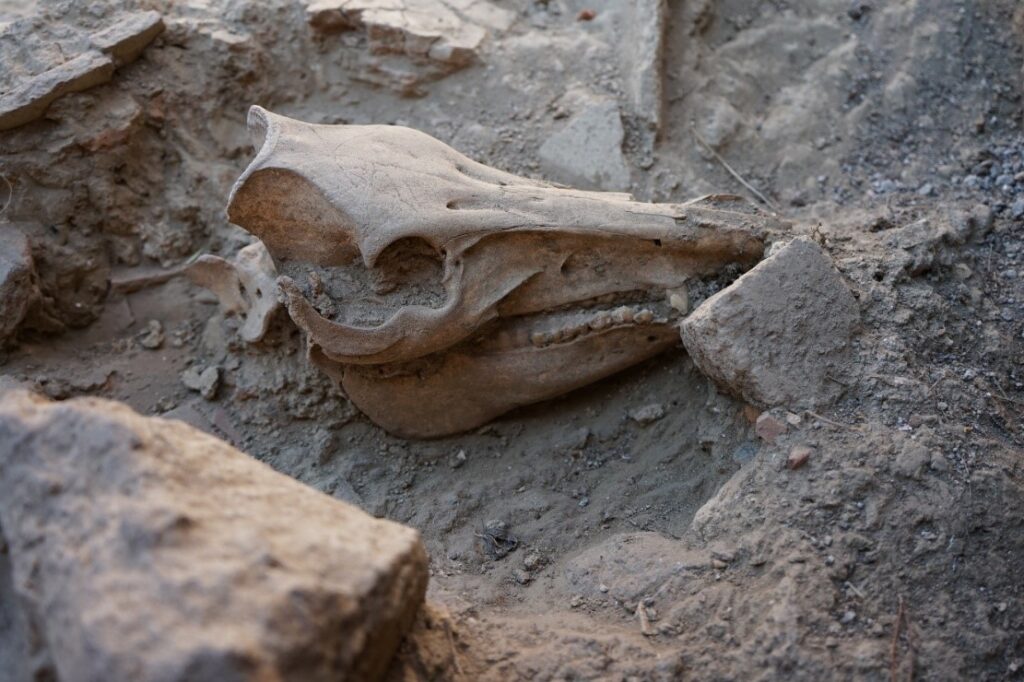For a number of years the OFP has been excavating the area of Ostia’s main forum. In 2016 excavations of the area known as TFR (Taberna Forum Rooms) were conducted, in the hopes of exposing structures predating the Hadrianic building program. The area revealed a previously unknown sanctuary, housing both a temple and alters with several building phases. The sanctuary is suggested by the OFP to belong to the god Vulcan, who was a prominent deity in ancient Ostia. The location of the Vulcan sanctuary has up until now been unknown but ancient texts identify him as the main deity of the city and locate his sanctuary to somewhere on the forum[1]. Early excavators believed the Capitolium to be the temple of Vulcan[2] but this has turned out to be incorrect. The finding of the Vulcan sanctuary on the forum is a major discovery, both because of his important position in the ancient city but also because the sanctuary would be the only discovered Vulcan sanctuary in the Roman Empire.[3] Many religious deposits were found among the sanctuary’s structures. The deposits mostly contained ceramic material, such as pottery both fine ware and cooking ware, as well as oil lamps. Several of the deposits also contained bones, including the heads of three sacrificial pigs.
Theme four focuses on studying the ritual practices of the sanctuary through the contents, location and development of the religious deposits. Reconstruction of ritual practice can be a difficult task. Unlike other humanistic fields, archaeologists are not able to ask the subjects of their research. Instead, we must study the remains of the cultic activity and puzzle our way to an answer.

Previously, religious deposits have not been ignored by scholars but have often been studied in a way that ignores the deposit’s context as well as the deposit as a context, and the information this can give. There are several reasons behind this. Firstly, the focus of scholars has mostly been on the individual objects, rather than the deposits as an assemblage. Secondly, it is in fact quite difficult to identify religious deposits. Especially at a site with many phases. Lastly, not studying single objects but a whole assemblage of objects means to study the cognitive aspect of ancient peoples – the way in which people in the past thought and felt. ‘Cognitive archaeology’ is a fairly new concept within the classical archaeological community.[4] In archaeological research, objects are mostly classified based on type and not context. This is because the classification of individual objects is essential to archaeological research, especially when creating a relative chronology, which has always been a vital part of understanding a site. However, ignoring the identification and classification of religious deposits as a collected context limits the information, we can gather from the sanctuary. In this thesis, the deposits will be treated as an amassed context. The focus will be on the location of the deposits within the sanctuary as an indicator of activity and the general types of objects indicating the nature of religious activity in the sanctuary.
You can find more here.
[1] There are several mentions of the priests of Vulcan in the Fasti Ostienses, which indicates the importance of the cult in Ostia. The sanctuary is also mentioned to be one of the oldest in the city.
[2] Among others Vagleri and Fenilli, who was the earliest archaeological excavators of Ostia Antica. In Fenilli’s excavation report ‘Giornale degli Scavi’ he refers to the area of the Capitolium as the Vulcan sanctuary.
[3] The suggested alter to Vulcan on the Forum Romanum is still a debatable identification and is not the first suggested location. See: Boni, G. 1900: ‘Esplorazioni nel Comizio’, NSc 9, 295-340. The site of a U-shaped altar and the later Niger Lapis have been interpreted as being the shrine to Vulcan by Coarelli. See: Coarelli, F. 1977: ‘Il Comizio dalle origini alla fine della repubblica’. PP 32 (1977). 166-238.
[4] Osborne, R. 2004: ‘Hoards, votives, offerings: the archaeology of the dedicated object’, World Archaeology, 36:1, 1-10.
